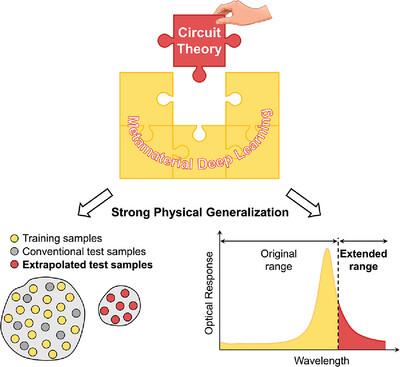当前位置:
X-MOL 学术
›
Laser Photonics Rev.
›
论文详情
Our official English website, www.x-mol.net, welcomes your
feedback! (Note: you will need to create a separate account there.)
Highly Intelligent Forward Design of Metamaterials Empowered by Circuit‐Physics‐Driven Deep Learning
Laser & Photonics Reviews ( IF 9.8 ) Pub Date : 2024-11-19 , DOI: 10.1002/lpor.202400724 Yiming Yan, Fajun Li, Jiaqing Shen, Mingyong Zhuang, Yuan Gao, Wei Chen, Yuyang Li, Zhilin Wu, Zhaogang Dong, Jinfeng Zhu
Laser & Photonics Reviews ( IF 9.8 ) Pub Date : 2024-11-19 , DOI: 10.1002/lpor.202400724 Yiming Yan, Fajun Li, Jiaqing Shen, Mingyong Zhuang, Yuan Gao, Wei Chen, Yuyang Li, Zhilin Wu, Zhaogang Dong, Jinfeng Zhu

|
The field of advanced metamaterial design has witnessed the great progress of artificial intelligence (AI) for science. Typically, the widely used deep learning is a purely data‐driven approach. However, it is often assumed as a black box performing interpolation among training data in a fuzzy way, which suffers from poor generalization outside the training domain of critical physical parameters. Inspired by physics‐guided deep learning, a circuit‐theory‐informed neural network (CTINN) in order to strengthen the generalization of metamaterial design is proposed. A series of plasmonic stack metamaterials (PSMs) are taken as learning paradigms of CTINN. Compared to conventional deep learning, the scheme decreases one‐order lower test loss of spectral prediction beyond the structure training span, and it possesses an extraordinary function to predict spectra of the extrapolated wavelength range. Due to the physics‐informed mechanism, the CTINN only adopts 10% training samples of the pure data‐driven counterpart, while it reduces >50% test loss. Moreover, the CTINN design is used to guide the PSM experiments and demonstrate its great potential for metamaterial development. This work introduces the theory of equivalent circuits into the neural network, empowers physics supervision to AI, and accomplishes the smart and powerful design of PSMs.
中文翻译:

基于电路物理驱动深度学习的超材料高智能正向设计
先进超材料设计领域见证了人工智能 (AI) 在科学领域的巨大进步。通常,广泛使用的深度学习是一种纯粹的数据驱动方法。然而,它通常被假设为一个黑盒,以模糊的方式在训练数据之间执行插值,在关键物理参数的训练域之外,它的泛化性很差。受物理引导深度学习的启发,提出了一种电路论信息神经网络 (CTINN),以加强超材料设计的泛化。一系列等离子体堆叠超材料 (PSM) 作为 CTINN 的学习范式。与传统深度学习相比,该方案在结构训练跨度之外将光谱预测的测试损失降低了一个阶,并且具有预测外推波长范围光谱的非凡功能。由于物理知情机制,CTINN 仅采用纯数据驱动对应物的 10% 训练样本,同时减少了 >50% 的测试损失。此外,CTINN 设计用于指导 PSM 实验并展示其在超材料开发方面的巨大潜力。这项工作将等效电路理论引入神经网络,赋予 AI 物理监督能力,并完成了 PSM 的智能和强大设计。
更新日期:2024-11-19
中文翻译:

基于电路物理驱动深度学习的超材料高智能正向设计
先进超材料设计领域见证了人工智能 (AI) 在科学领域的巨大进步。通常,广泛使用的深度学习是一种纯粹的数据驱动方法。然而,它通常被假设为一个黑盒,以模糊的方式在训练数据之间执行插值,在关键物理参数的训练域之外,它的泛化性很差。受物理引导深度学习的启发,提出了一种电路论信息神经网络 (CTINN),以加强超材料设计的泛化。一系列等离子体堆叠超材料 (PSM) 作为 CTINN 的学习范式。与传统深度学习相比,该方案在结构训练跨度之外将光谱预测的测试损失降低了一个阶,并且具有预测外推波长范围光谱的非凡功能。由于物理知情机制,CTINN 仅采用纯数据驱动对应物的 10% 训练样本,同时减少了 >50% 的测试损失。此外,CTINN 设计用于指导 PSM 实验并展示其在超材料开发方面的巨大潜力。这项工作将等效电路理论引入神经网络,赋予 AI 物理监督能力,并完成了 PSM 的智能和强大设计。


















































 京公网安备 11010802027423号
京公网安备 11010802027423号